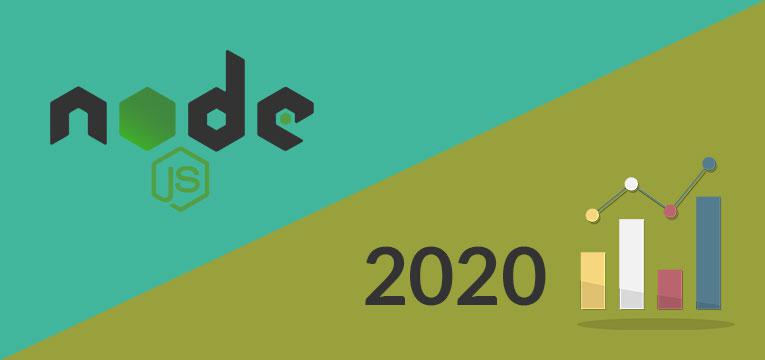The Leading Nodejs Trends for Web App Development
To bring end to the most debatable concern among developers that whether Nodejs is a framework or platform or it is a runtime environment? Well, all of you have assumed it to be a framework because it uses JavaScript for providing support. It is an open-source, cross-platform, JavaScript runtime environment that is used to accelerate the output and the process of development. If you are planning to use Node.js for your upcoming development projects, our advice would be to take up because its ability to cater to client-side services as well as server-side will make it cost-effective too for users.
Without much ado, you must start taking steps towards developing apps using Nodejs. This will be a thorough comprehensive guide towards understanding Node.js development, the involved top frameworks and then some of its key features of Node.js. But do not stop there because the main highlight of this blog is the current trends in Node js and how using those trends will make you ahead of your peers in this competitive world.
1. What is Node js Development?
In simple words, NodeJS is an open-source cross-platform JavaScript run-time environment mainly used to build scalable server-side web and mobile apps; but now being able to assist in any kind of small or large projects – all thanks to its growth and popularity. Featuring an ample library, tools, and software, the tech allows developing fast and scalable web apps that usually runs on Microsoft Windows, Linux, or OS X.
Also, NodeJS is single-threaded which means it can easily employ a concurrency model on the basis of an event loop. All this happens without even blocking the execution. In simple words, the tech has the potential to handle concurrent operations without creating any multiple threads of execution.
Best used cases of NodeJS development services include creating I/O Bound applications, Data Streaming applications, robust real time apps, JSON APIs based mobile app development, Single Page web app development.
Also, it does offer a plethora of benefits such as:
- A reliable open-source network platform
- With the help of JavaScript modules; best server-side web applications can be built
- The Lightweight framework comprises of bare minimum js modules
- Being asynchronous; it works way faster than other frameworks
- The cross-platform framework effectively runs on Windows, Mac & Linux etc multiple platforms.
2. Top NodeJS Frameworks
In the mobile app and web development realm, everything seems to be drastic and consistent in regards to NodeJS. The aforementioned benefits have inspired lots and lots of developers to choose NodeJS framework. Further below I would like to mention some of the most popular js frameworks worth taking into account.
- Meteor.JS – One of the best reasons for choosing Meteor.js is that it is not suitable for all apps, especially games. And since all major websites are mobile compatible, wrapping it in a web browser and releasing it in a seamless manner makes perfect sense.
Over the years, the framework hasn’t pretty much changed as prototyping an app has always been quick. Also, no API needs to be set up or any security around it other than app-based logic. There is no need to rewrite it as a proper app. In simple words, keep working on the framework and polish the design and execute js code. It may also interest you to know that by analyzing things in a clever manner, you can design the app in such a manner that it feels like a native app by using pop-ups for new screens to stimulate Android Activities.
- Express.JS – Most of the NodeJS app developers including us often seek around for frameworks that are fast, popular, and flexible featuring a powerful collection of features for both web development as well as mobile application development. Express.js is one such name to reckon with an amazing API allowing its end-users to send and receive certain requests and eases the coordination between frontend and database.
Right from allowing you to plot single and multi-page with different web applications to available with Model View Controller to create eccentric applications to rendering large HTML pages dynamically and allowing NodeJS developers to respond to HTTP requests with the help of a software glue are some of the vital benefits offered by Express.js. The framework also comes with a multiple view support system with I/O and robust and powerful backend API making routine easier and faster.
- Koa.JS – With 29000+ stars on GitHub and more than 330K npm weekly downloads, Kao.js is another interesting software development framework worth considering. Built by the same team of Express.js, this one is smaller, costlier, and has a more robust foundation for web applications and APIs. Here professionals can easily ditch callbacks and increase error-handling, by leveraging async functions. What does a Koa application look like? It comprises an object containing an array of middleware functions mainly composed and executed in a stack-like manner upon request.
Right from improving interoperability, robustness, and making writing middleware more enjoyable to being lightweight (550 lines of code) to offering great user experience and error handling, cleaner & more readable async code are some of the advantages of using Kao.js. Now that you can stop using callbacks and deal with errors in a faster manner, the tech allows you to build web applications with great performance. Other than this, improved security can be achieved as the framework comprises different middlewares and headers.
- Nest.JS – Another open-source framework that uses TypeScript worth mentioning is Nest.js. According to State of JavaScript 2019, NestJS won first place in the Backend Technologies predictions section. So if by any chance you are dealing with large and complicated projects, make sure to use Nest that comes handy. Based on Express, Nest definitely amazes me in several ways such as:
- Gives NodeJS service providers an ability to interact with your database abstractly. All you have to do is create and annotate classes with decorators.
- Create service layer classes to handle the business logic of your application.
- Controllers are created that respond to HTTP requests.
- Secure all the endpoints that have been created with controllers right from the start.
- Create microservices with Nest. Cool.
- Build a GraphQL Interface easily
- Hapi.JS – GitHub rates Hapi.js with 11000+ stars with 250K weekly downloads, the NodeJS development framework is highly recommended for building applications and services. Also, the frameworks enable developers to focus on composing reusable application logic as opposed to going through a long stretch of time in building foundation every single time when out of luck. Right from providing a robust plugin system allowing you to add new features/fixing bugs at a fanatic pace, enables to build scalable APIs, get a deeper control over request handling, detailed API reference and good support for document generation, the rare availability of caching, authentication, and input validation, and provides good enterprise plugins such as joi, yar, catbox, boom, tv, and travelog.
3. Some Key Features that Make NodeJS Popular
- Server and Hardware – One of the crucial factors of NodeJS is that performance can be determined easily. Ample time, energy, and money are being saved resulting in a more effective development process. With a good amount of improvement in project quality, the cost automatically gets lowered.
- Scalability & Reusability – It may quite interest you to know that every NodeJS web and mobile development services are performance-oriented and have the potential to significantly impact the execution speed and scalability of the project. Another interesting aspect here is that only the part of the affected code needs to be changed rather than changing the entire coding structure. Also by reducing logic replication, the framework can be used by multiple applications.
- Microservices – Code maintenance becomes easy in regards to functioning as microservices aim to support the no-server approach and enhances effectiveness in projects.
- Real-time apps – Another most common use of NodeJS is building real-time applications. Apps featuring this real-time to create a more prominent level of client commitment. More and more platforms like social networks, live chats, gaming apps, ad servers, stock exchange software are emerging and are rising, expressing that speed is everything today! In fact, hundreds and thousands of data-intensive and real-time IoT devices & apps can be served by utilizing NodeJS applications. Nonetheless, in real-time apps, the danger of overburdening the server is amazingly high. But NodeJS makes the collaboration environment update seamlessly due to Event API and Web Sockets. Trello is the best example of a web-app where there is real-time collaboration. Some of the best examples of real-time applications include video conference app, document sharing, voice over internet protocol, online gaming, eCommerce transactions like stockbroking, chatting apps, instant messaging such as WhatsApp.
- Internet of things (IoT) – As I said before, NodeJS is a runtime environment used not only to run and create IoT apps but acts as a solid match for building IoT applications since it permits you to execute microservices, real-time capabilities, and data-centric approaches. Quicker and constant execution are the two main advantages of using NodeJS in IoT applications. NodeJS possesses less memory and low asset necessities on the server-side. In this manner, engineers can make versatile and productive applications.
4. The Leading Trends of NodeJS Development
1. Serverless Architecture
Being popular for its serverless architecture, Node JS allows you to create an application without having to worry about the maintenance of servers. The serverless architecture means reduced reliance on hardware and servers. And because of the serverless architecture, the framework offers a wide range of benefits in regards to code quality, diminished project cost, reusable code modules, and better flexibility.
2. GraphQL deployment in Node JS Apps
GraphQL is a data querying and manipulation programming language for APIs being developed by Facebook. In the year 2019, GraphQL saw the highest peak in its popularity. Interestingly, it is still growing and is all set to dominate Node.JS development trends in 2022.
With the help of GraphQL, NodeJS developers can easily make use of the sources of multiple data. It even facilitates the workflow of an application on a wide range of platforms and offers sample placeholder structures for the new ones. Lastly, the moment you incorporate GraphQL in any existing NodeJS application, its ability to fetch data increases by at least 50%.
3. Cloud Solutions
As the point implies, here we will be discussing building and editing existing cloud apps with NodeJS. The serverless structure provides great assistance in simplifying the cloud app construction right from the scratch.
Keeping the intense popularity of Node.JS development in mind, Google has come up with a wide range of NodeJS tools available for web developers that can be used for faster cloud application development. Also, one cannot deny the fact that cloud computing, artificial intelligence, and machine learning models will be ruling the world in the future.
4. MEAN & MERN Stack
Developers must be knowing what MEAN stack has and how it differs from MERN stack. Both these stack technologies are different, like if we speak of MEAN then in Mean, it includes MongoDB, Express, Angular and Node , with the use of these development technologies you can build complicated applications with ease. Another name in this stack is MERN- In this type it includes MongoDB, Express, React, Node.JS. These open source applications allow developers to create innovative and new-edge frontend web apps.
Both these MEAN and MERN stacks are supported by JavaScript programming and it would be helpful coding in every way possible. The primary distinction between the MEAN and MERN stacks is the use of Angular and React, respectively. Both stacks exhibit both positive and negative traits.
5. Internet of Things
The use of the latest technology like IOT and adding it with Node.js leads to many innovative and high-performing applications. Nodejs allows you to utilize its feature-rich runtime environment, it also enables developers to develop data-oriented, on-time capabilities, and microservices.
Now that we have accepted technological advancements and alterations, it’s equally important to keep up with modern technology and adapt one for their business. Because real-time apps must manage a high volume of user requests, node.js has proven to be a valuable asset. It not only creates high-quality apps but also a sure-fire solution.
Thus, it is advisable to rely on node.js to assist you in creating IoT Apps for your clients.
6. Real-time Applications
Real-time apps for a variety of online activities were in demand in 2021, and real-time apps were the most common cause for the existence of Node.js. Because of their high user engagement, real-time apps provide not just a plethora of amazing features, but also speed. These programmes offer features such as live discussions, social media integration, ad servers, gamification, stock market functionality, and others. Node.js meets all of the ecosystem’s requirements.
Node.js programmes can serve hundreds of servers for data-intensive and real-time IoT device apps. These real-time apps, however, have one disadvantage: they may generate server overload. The Event API and Web Sockets in Node.js allow the collaborative environment to update in real-time. Trello is a well-known example of a web application.
7. Microservice
Microservices are commonly used names in the development process. Microservices are critical processes allowing the serverless method of developing and building enterprise-grade projects. Microservices gives you a wide range of benefits in terms of performance and debugging by breaking down individual components of your programme into discrete and important services. With Node.js, creating microservices is extremely simple.
One of the most effective qualities of microservices is their capacity to provide a serverless architecture, which helps in the creation of large applications. In recent years, many large platforms including Facebook, Netflix, Amazon, and eBay have started to use monolithic systems for their suite of microservices. This makes microservices architecture increasingly popular.
8. Scalability
With Node.js, scalability is easy but a high concern. It is an important component of the runtime’s structure. When you use Node, you are clearly emphasizing on the Node app which was created using many little distributed nodes that communicate with one another.
The cluster module in Node not only provides an out-of-the-box solution for utilizing a machine’s full CPU capacity. But it also helps to improve the availability of your Node operations and allows you to resume the entire application without any interruption. Also, when you build applications using Node, you are already introducing scalability for your applications. Node.js is already scalable and using its components makes it more easy and adaptable to use.
6. Conclusion
So, That’s all for now! Node.JS development has been gaining lots and lots of traction lately. The aforementioned node js trends will surely play a decisive role in the web development and mobile app development realm to ensure the scalability of the application. This means you have no reason not to trust the technology and eTatvaSoft – your reliable NodeJS mobile app development company.
Angular is third most preferred web Framework. We cannot say that technology is tricky in terms of use but the goal is to accomplish demand...
 Jul 3, 2020
Jul 3, 2020 



Great content! These are some amazing trends of Node.js development for 2020. I'm waiting for more of your content. Kindly don't stop writing such amazing blogs. Keep sharing the knowledge.
Thanks for showing interest in sharing your knowledge, one of the in-depth article I’ve ever read.
Nodejs itself is a kind of emerging framework and gaining more popularity day by day. Thanks for sharing this Nodejs development trends. It will surely help Nodejs Developers to focus on what they need to focus on.